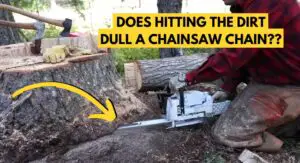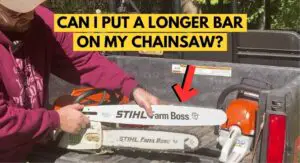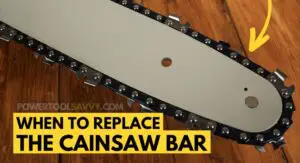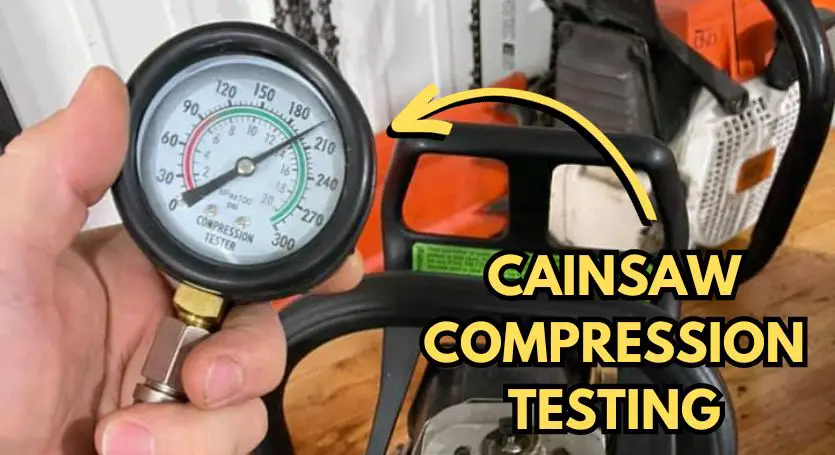
How to test the compression on a chainsaw?
To test chainsaw compression, remove the top cover and the spark plug, then attach the adapter to the spark plug hole and connect the compression gauge. With the throttle wide open, crank the engine 5-10 times, until the gauge stops rising. Note down the reading and reassemble your chainsaw.
Sounds confusing??
Don’t worry!
In this article, I’m going to break down the process of chainsaw compression testing into simple, easy-to-follow steps.
So let’s get started!
Table of Contents
ToggleStep-By-Step Chainsaw Compression Testing Guide
To be honest, testing the compression on a chainsaw isn’t that complicated. All you need is a small engine compression tester (with the right adapter) and you’re ready to go.
Once you’ve got that, just follow these simple steps to test your chainsaw engine compression: 👇
Step 1: Prepare Your Chainsaw
In this step, you’ll need to prepare your chainsaw for the compression test.
First, take off the top cover & remove the spark plug using a scrench.
Next, screw the adapter into the spark plug hole and hook up the compression gauge to it. (Don’t overtighten the adapter & make sure the gauge is zeroed!)
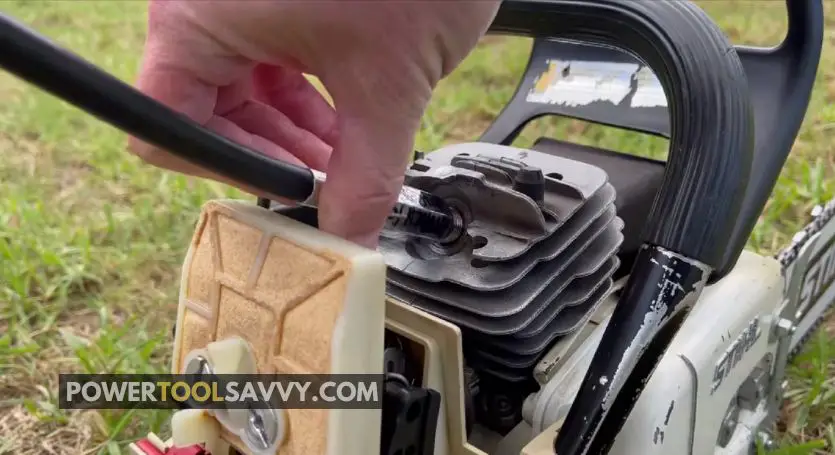
Step 2: Crank the Engine
Now, hold the throttle wide open with your leg (you could also use zip ties) and pull the starter cord until the gauge stops climbing. Normally, 5-10 pulls should do the trick!
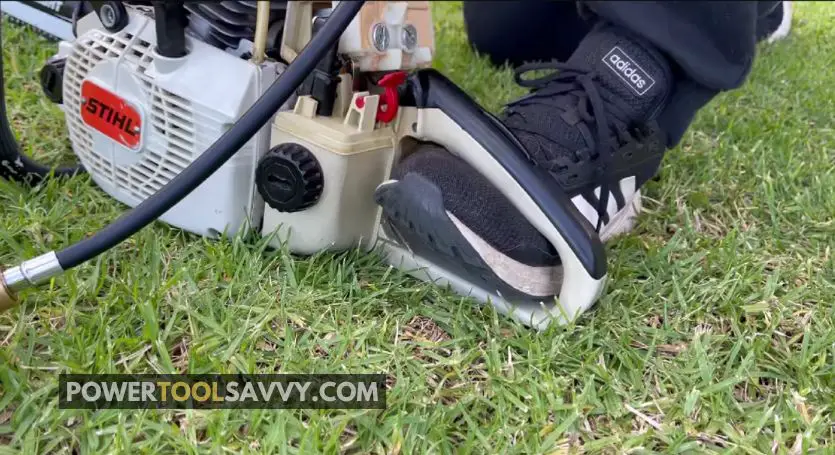
Step 3: Read the Compression & Reassemble
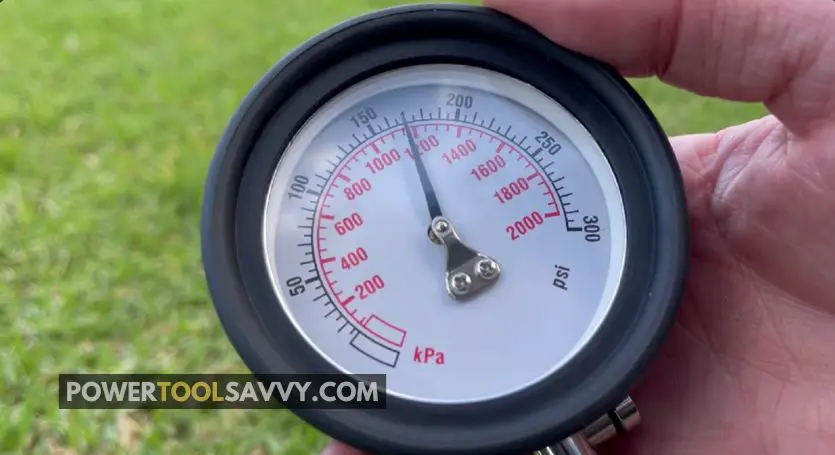
After a few pulls, you should see the pointer on the gauge stop moving. That’s your compression reading!
Ideally, you should get a reading between 120-160 psi for most chainsaw engines. If it’s less than 120 psi, it’s a SIGN of worn-out piston rings, leaky gaskets, or cylinder wall damage.
| Engine Compression (psi) | Status |
|---|---|
| 150-160 | Good |
| 120-150 | Okay |
| Below 120 | Bad |
Read this article to learn more about chainsaw compression & why it’s so important!
When you’re DONE –
- ✅ remove the compression gauge,
- ✅ reinsert the spark plug,
- ✅ and put back the top cover.
Can You Test Chainsaw Compression Without a Gauge?
If you don’t have a gauge (or any compression tester) but still want to check the engine compression, there’s a simpler way. It’s called the “hanging test“.
Here’s how to do it: 👇
- Grab your chainsaw by the starter cord & let it hang.
- If it falls down easily, low compression is probably the issue.
- If it’s stiff & you feel resistance, compression’s probably fine! (You still need to do a proper diagnosis though!)
✍️ Note: As you’ve already guessed it, this isn’t the most accurate method for testing chainsaw compression. But it’s still better than nothing (especially if you’re in a hurry!).
Symptoms of Low-Compression in Chainsaw
If you’ve got a chainsaw with low compression, it’s not going to be a secret for long.
Here are a few common signs you’ll notice:
- Engine misfires
- Failure to start
- Poor fuel efficiency
- Loss of power
- Unusual sounds
- Little to no resistance on the pull cord
If you experience any of these symptoms, grab your compression tester and follow the steps outlined above to figure out what’s going on with your chainsaw!
Choosing the Right Compression Tester for Your Chainsaw
Well, it’s not rocket science! 🚀
You go to the store, buy a compression tester, and that’s it! (Or if you’re smart like me, you order one online & save some bucks!)
But here are a few things you should keep in mind while choosing a compression tester for your chainsaw: 👇
- ✅ Make sure it says “Small Engine Compression Tester.”
- ✅ Make sure it has the right adapter for your spark plug. Most chainsaws have 10mm, 12mm, and 14mm (thread diameter) spark plugs.
- ✅ Check if the hose pipe has a Schrader valve in the end. (It’s basically a one-way valve that prevents the loss of pressure & gives you a more accurate reading. Plus, it allows you to bleed off pressure without taking the hose out of the spark plug hole!)
- ✅ Finally, make sure the tester has at least 200 psi capacity. (Although, almost all small engine compression testers have a 300 psi max capacity, so you’re good to go!)
Price??
I leave it up to you because they’re all priced around $30-80 (unless you’re throwing some fancy stuff into your shopping cart 😜).
Best Compression Tester that I've Used
Here are 3 of the BEST compression testers that I’ve used: 👇
Mityvac MV5530 (My Favorite)
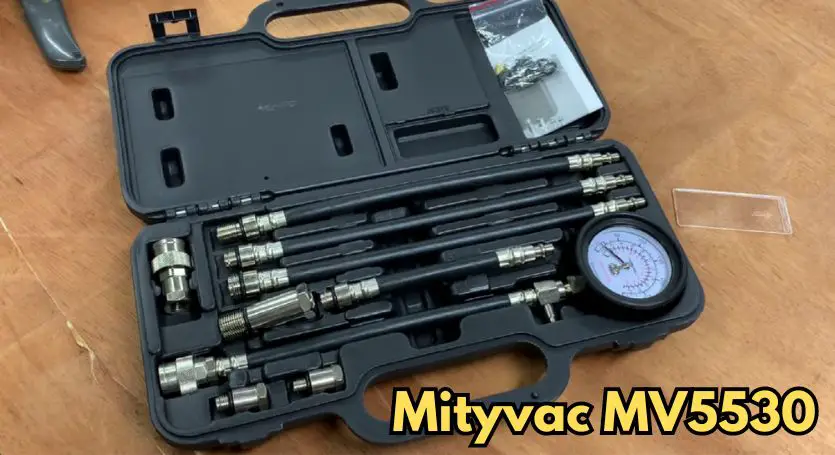
A couple of years ago, I wasted my money on a cheap $20 compression tester. It lasted only for 3-4 tests before the hose & gauge started leaking!
So, I ordered this Mityvac MV5530 (paid around 50$) and it has been going strong till now!
PROS:
- ✅ Reasonably priced (check the latest price).
- ✅ It comes with a nice little “durable” black case.
- ✅ It includes 4 extended hoses, 2 small engine adapters (10mm & 12mm), and 2 Schrader valves.
- ✅ Build quality is superb!
CONS:
- ❌ I don’t know why but it takes more pulls than any other tester I’ve used.
OTC 5606 (Runner Up)
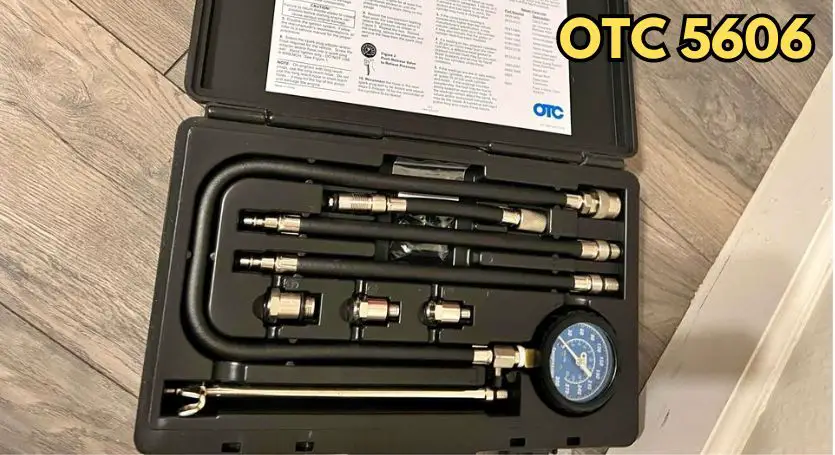
OTC is one of the most reliable brands when it comes to compression testers.
PROS:
- ✅ This kit comes with 2 extended hose pipes, 3 standard spark plug adapters (10mm, 12mm, 18mm), and 2 Schrader valves.
- ✅ The gauge pipe is 25″ long, so there’s no more struggling!
- ✅ The gauge has both psi (0-300 psi) & kPa scales (0-2100 kPa).
CONS:
- ❌ It’s more expensive than the Mityvac (check the latest price here).
- ❌ I personally don’t like the “molded” case as much.
BETOOLL HW0130 (Best Budget Deal)
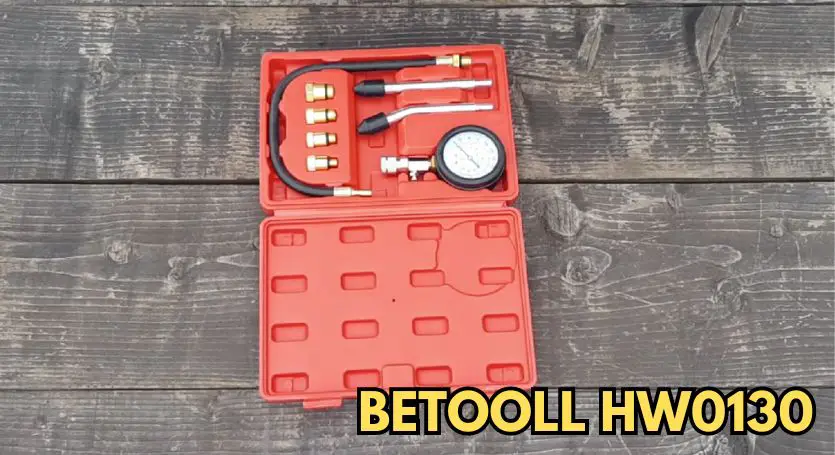
PROS:
- ✅ Extremely cheap! (less than $20)
- ✅ It comes with 4 adapters (10mm, 12mm, 14mm, 18mm) and a 17.7″ extended hose pipe.
- ✅ The build quality is decent for this price.
- ✅ It comes with a “bonus” plastic carrying case (unlike most testers at this price point).
CONS:
- ❌ No Schrader valve obviously!
- ❌ No additional hose pipe.
- ❌ Struggles with higher compression readings (200 psi+).
I bought this one only to see if budget testers are worth your money or not! And tbh, it’s a great buy if you’re looking for something cheap & functional. (Check the latest price here)
The only downside is that it struggles to hold pressure readings above 200 psi.
But if you’re only going to use it on small engines (chainsaws, lawnmowers, etc.), you won’t have any issues with it!


